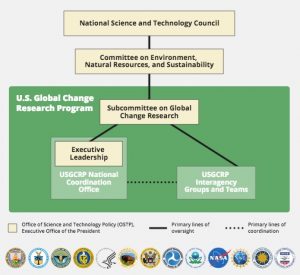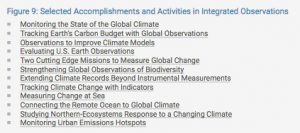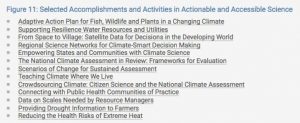CLIMATE CHANGE REPORTS
The United States Global Change Research Program (USGCRP)
The United States Global Change Research Program (USGCRP) is a federal program that was started by President Ronald Reagan in 1989 and it has been mandated Congress since then to coordinate federal research and investments in better understanding the forces and factors shaping the global environment (human and natural) and their impact on society.[1]
The USGCRP program is directed and overseen by the Subcommittee on Global Change Research (SGCR), which is chartered under the Committee on Environment, Natural Resources and Sustainability (CENRS), a part of the National Science and Technology Council (NSTC). A significant portion of the program’s work is coordinated through its Interagency Working Groups, with significant participation from member and non-member science-focused and mission-focused federal agencies.

Source: The National Global Change Research Plan 2012–2021: A Triennial Update
The USGCRP program facilitates collaboration and cooperation across its 13 federal member agencies to advance our understanding of the changing Earth and how we can maximize efficiencies in federal global change research.[2] The 13 federal member agencies include:
- Department of Agriculture
- Department of Commerce
- Department of Defense
- Department of Energy
- Department of Health & Human Services
- Department of the Interior
- Department of State
- Department of Transportation
- Environmental Protection Agency
- NASA
- National Science Foundation
- Smithsonian Institution
- US Agency for International Development
Representatives from each of these agencies come together to form the Subcommittee on Global Change Research of the Committee on Environment within the National Science and Technology Council.[3]
There are also Interagency Working Groups, which are responsible for activities in their respective research areas. The groups are overseen by the Subcommittee on Global Change Research and they are comprised of representatives from federal departments and agencies responsible for the activities in each research area. The Interagency Working Groups include the following:
- Carbon Cycle Interagency Working Group
- Federal Adaptation and Resilience Group
- Indicators Interagency Working Group
- Integrated Observations Interagency Working Group
- Interagency Crosscutting Group on Climate Change and Human Health
- Interagency Group on Integrative Modeling
- Interagency Integrated Water Cycle Group and the US Global Energy and Water Exchanges Program Office
- International Activities Interagency Working Group
- Social Science Coordinated Committee
- Sustained Assessment Working Group
The USGCRP has a 2012-2021 Strategic Plan, which was updated in 2017. Congress has mandated that the USGCRP develops a new strategic plan every 10 years. The Strategic Plan provides a framework for carrying out the program’s mission and implementing its goals. The broad goals for the USGCRP include advancing global change science, informing decisions, sustaining scientific assessment, and engaging the public on the science of global change and its use in society.[4] The 2017 update covers the focus areas that were the USGCRP interagency priorities for fiscal years 2015, 2016, and 2017--these focus areas include arctic research and resilience, water cycle extremes, and methane cycling within the carbon cycle context.[5]
To identify and make progress on emerging science needs USGCRP has developed core capabilities that provide critical knowledge and methodologies to the program. They include:
Integrated Observations. Observations are at the heart of USGCRP’s ability to understand climate-related global change and its impacts (see Figure 9).

Source: The National Global Change Research Plan 2012–2021: A Triennial Update
Predictability and Integrative Modeling. This core capability addresses knowledge gaps that are common to both climate prediction and climate-change impact modeling (see Figure 10).

Source: The National Global Change Research Plan 2012–2021: A Triennial Update
Actionable and Accessible Science. Assessments, including National Climate Assessments (NCAs), are a key element of USGCRP’s programming in this arena (see Figure 11).

Source: The National Global Change Research Plan 2012–2021: A Triennial Update
The USGCRP Reports Library allows anyone to browse scientific assessments, annual reports, strategic research plans, fact sheets, brochures, and other resources produced by USGCRP, its participating agencies, and related organizations. Notable reports and resources include, among others:
- Our Changing Planet: The US Global Change Research Program for Fiscal Year 2020
- Fourth National Climate Assessment, Vol. II: Impacts, Risks, and Adaptation in the United States (2018)
- Fourth National Climate Assessment, Vol. I: the Climate Science Special Report (2017)
- State Climate Summaries
- U.S. Climate Resilience Toolkit
- Climate Data Initiative
Updated June 2022 by Kristin Stiner

Comments are closed.